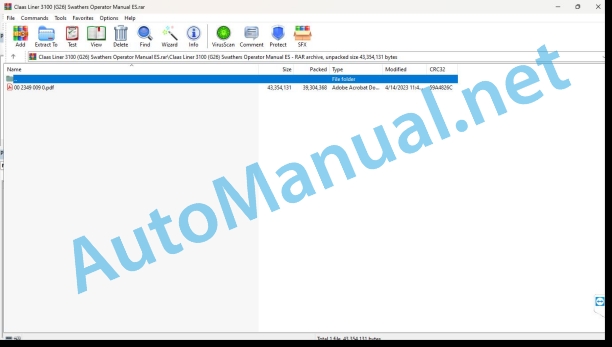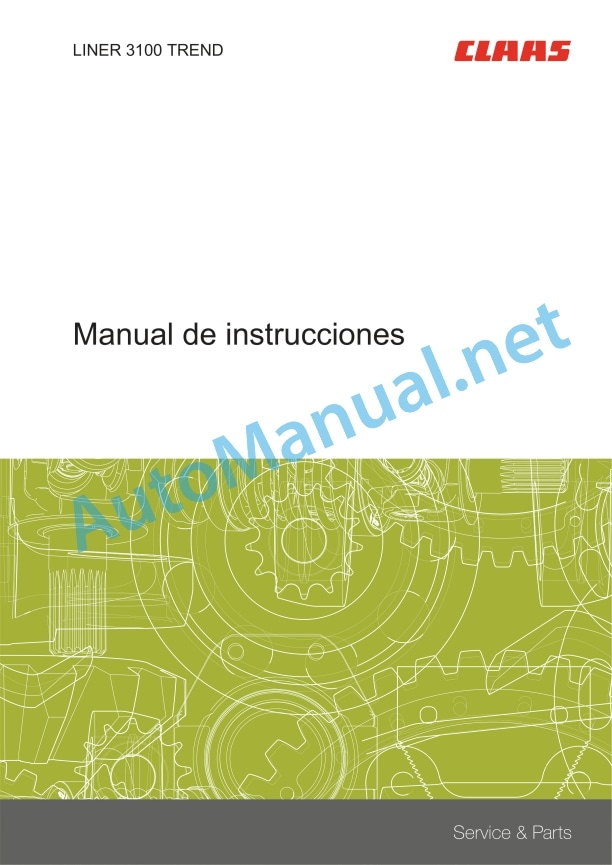Claas Liner 3100 (G26) Swathers Operator Manual ES
$50.00
- Model: Liner 3100 (G26) Swathers
- Type Of Manual: Operator Manual
- Language: ES
- Format: PDF(s)
- Size: 37.5 MB
File List:
00 2349 009 0.pdf
00 2349 009 0.pdf:
LINER 3100 TREND
1. Introduction
1.1 Information regarding the instruction manual
1.1.1 Validity of the manual
1.1.2 Information about this instruction manual
1.1.3 Symbols and indications
1.1.4 Optional equipment
1.1.5 Qualified specialized workshop
1.1.6 Information regarding warranty
1.1.7 Spare parts and technical issues
1.2 Proper application of the machine
1.2.1 Proper machine application
1.2.2 Logically foreseeable inappropriate application
2 Security
2.1 Recognize warning signs
2.1.1 Danger symbols
2.1.2 Keyword
2.2 Safety instructions
2.2.1 Meaning of the instruction manual
2.2.2 Observe graphic danger symbols and alarm indications
2.2.3 Requirements for all people working with the machine
2.2.4 Children in danger
2.2.5 Danger zones
2.2.6 Position yourself between the tractor and the machine
2.2.7 Accompanying persons
2.2.8 Couple the tractor with the machine
2.2.9 Risk of injury due to rotating shafts
2.2.10 Construction modifications
2.2.11 Optional equipment and spare parts
2.2.12 Control of the machine in operation
2.2.13 Operation only after correct commissioning
2.2.14 Technical status
2.2.15 Danger due to machine breakdowns
2.2.16 Comply with technical limit values
2.2.17 Danger due to coasting parts
2.2.18 Maintain functional protection devices
2.2.19 Personal protective equipment
2.2.20 Wear appropriate clothing
2.2.21 Remove dirt and loose objects
2.2.22 Prepare the machine for road traffic
2.2.23 Dangers when driving on the road and in the countryside
2.2.24 Park the machine safely
2.2.25 Parking without supervision
2.2.26 Unsuitable consumables
2.2.27 Safe handling of consumables and auxiliary materials
2.2.28 Environmental protection and waste disposal
2.2.29 Fire protection
2.2.30 Deadly electrical discharge through overhead lines
2.2.31 Behavior in the case of an overhead line voltage transfer and lightning strike
2.2.32 Liquids under pressure
2.2.33 Hot surfaces
2.2.34 Work only on the stopped machine
2.2.35 Maintenance work and repair work
2.2.36 Machine parts and lifted loads
2.2.37 Danger from welding work
2.3 Safety signage
2.3.1 Structure of graphic hazard symbols
2.3.2 Position of warning symbols on the machine
3 Machine Description
3.1 Summary and operation
3.1.1 Machine overview
3.1.2 Machine operating mode
3.2 Optional equipment
3.2.1 Hydraulic adjustment of the height of the swath rotors*
3.2.2 Individual lifting* with 2 hydraulic hoses
3.2.3 Individual lifting* with control panel
3.2.4 Windrowing canvas*
3.2.5 Spare wheel*
3.2.6 Mudguards*
3.2.7 Legal technical equipment of the European Union*
3.3 Identification plates and vehicle identification number
3.3.1 Spare parts and technical questions
3.3.2 Machine identification plate
3.4 Machine information
3.4.1 Adhesive on the machine
4 Control and display instruments
4.1 Control elements
4.1.1 Hydraulic hose
4.1.2 Windrowing canvas*
4.1.3 Support leg
4.1.4 Windrower rotor
4.1.5 Individual lifting of swath rotors* with 2 hydraulic hoses
4.1.6 Individual lifting of rotors* with control desk
4.2 Indicator elements
4.2.1 Hooking device
4.2.2 Outgoing arm
Working width scale
Latching arrows for transportation
4.2.3 Swath rotor chassis
5 Technical data
5.1 LINER 3100 TREND
5.1.1 Dimensions
5.1.2 Weights
5.1.3 Tractor requirements
5.1.4 Version
5.1.5 Tire pressure
5.1.6 Lubricants
6 Preparation of the machine
6.1 Turn off the machine and secure it
6.1.1 Shut down and secure the machine and tractor
6.1.2 Secure the lifted machine
6.2 Adapt the tractor
6.2.1 Front axle counterbalancing
6.2.2 Check the tractor power take-off protection device
6.3 Adapt the machine
6.3.1 Check the length of the cardan shaft
Shortest working position of the cardan shaft
Longest working position of the cardan shaft
6.3.2 Adapt the length of the cardan shaft
6.3.3 Assemble the cardan shaft to the machine
6.3.4 Fill cargo filling in the case of individual lifting*
6.4 Hooking up the machine
6.4.1 Remove the security lock*
6.4.2 Attach the hitch bracket
Secure drawbar hooks so they cannot be opened accidentally
6.4.3 Assemble the cardan shaft
6.4.4 Attach the safety chain*
6.4.5 Place the support leg upwards
6.4.6 Connect the hydraulic hoses
Summary of hydraulic connections
Connect the hydraulic hose to raise and lower the swath rotors
Connect the hydraulic hoses to carry out the telescopic movement of the swath rotors
6.4.7 Connect the hydraulic hoses for the hydraulic height adjustment of the swath rotors*
6.4.8 Connect the individual lift hydraulic hose*
6.4.9 Assembling the individual lift control panel*
6.4.10 Plug in the lighting cable
6.4.11 Attach the pull rope
6.4.12 Save the shims
6.5 Unhooking the machine
6.5.1 Park the machine safely
6.5.2 Put the shims underneath
6.5.3 Unhook the pull rope
6.5.4 Unplug the driving lighting cable
6.5.5 Uncouple the hydraulic pipes
6.5.6 Disconnect the hydraulic hoses from the hydraulic height adjustment of the swath rotors*
6.5.7 Disconnect the hydraulic hose from the individual lift*
6.5.8 Remove the individual lift control panel*
6.5.9 Remove the support leg
6.5.10 Unhook the safety chain*
6.5.11 Dismantle the cardan shaft
6.5.12 Unhook the coupling bracket
6.5.13 Engage the safety lock*
6.6 Prepare for road traffic
6.6.1 Folding the protective stirrup
6.6.2 Remove the tine holder
Carry spare tine holders in the central chassis
6.6.3 Fold the machine into transport position
6.6.4 Insert the protective bars
6.6.5 Close the stopcock
6.6.6 Check before driving on the road
6.7 Prepare for use at work
6.7.1 Remove protective bars
6.7.2 Open the stopcock
6.7.3 Deploy the machine to the working position
6.7.4 Assemble the tine holders
Remove the replacement tine brackets from the bracket on the center chassis
6.7.5 Deploy the protective stirrup
6.8 Load the machine
6.8.1 Lift the machine
7 Management
7.1 Driving on the road
7.1.1 Circulation on public roads
7.2 Settings for use at work
7.2.1 Adjust the swath rotor
Basic adjustment of tandem axles
7.2.2 Mechanically adjust the raking height
7.2.3 Hydraulically adjust the raking height*
7.2.4 Adjust the swath cloth*
7.2.5 Adjust the height of the headrest position
7.2.6 Setting the working width and row width
7.2.7 Adjust the steering stop
7.3 Use at work
7.3.1 Fold the machine into transport position
Adjust transport height
7.3.2 Deploy the machine to the working position
7.3.3 Raise the swath rotors to the headland position
7.3.4 Using the machine
7.3.5 Adapt the power take-off speed
7.3.6 Observe the stop angle
7.3.7 Make rows
7.3.8 Windrowing without swath cloth*
7.3.9 Install the individual lift with 2 hydraulic hoses*
Work with a single swath rotor
Lifting a swath rotor from the working position
Lowering a swath rotor from the headland position
Both swath rotors lowered to working position
Lifting lock function for individual lifting rotors
7.3.10 Setting up the individual lift* with control panel
Work with a single swath rotor
Working with the right swath rotor
Working with the left swath rotor
8 Incident and solution
8.1 Chassis
8.1.1 Change the wheel on the transport chassis
8.1.2 Change the feeler wheel
Rear tandem axle*
8.1.3 Faults in the feeler wheels
8.1.4 The machine advances offset with respect to the tractor
Adjust the drawbar
8.1.5 Large tire wear
Adjust convergence
8.2 Electrical installation
8.2.1 Faulty lighting
8.3 Windrower rotor
8.3.1 Hydraulic installation
9 Maintenance
9.1 Summary of maintenance intervals
9.1.1 Before harvest
9.1.2 After the first 10 hours of service
9.1.3 After the first 50 hours of service
9.1.4 Every 8 hours of service or daily
9.1.5 Every 20 hours of service
9.1.6 Every 50 hours of service
9.1.7 Every 100 hours of service
9.1.8 Every 250 hours of service
9.1.9 Every 500 hours of service or annually
9.1.10 Every 2 years
9.1.11 Every 5 years
9.1.12 After harvest
9.2 Gearbox
9.2.1 Check the tightness of the gear
9.2.2 Check the timing gear oil level
9.2.3 Change the timing gear oil
9.2.4 Check the swath gear oil level
9.2.5 Change the swath gear oil
9.2.6 Check the swath gear screws
9.3 Clutch
9.3.1 Check the overload clutch
9.3.2 Ventilate the friction clutch
9.3.3 Clean the cardan shaft friction clutch
9.4 Cardan shaft
9.4.1 Maintenance of cardan shafts
9.4.2 Check the cardan shaft nuts
9.5 Chassis
9.5.1 Check tire pressure
9.5.2 Check the wheel nuts on the transport chassis
9.5.3 Check the wheel nuts on the swath rotor chassis
9.6 Hydraulic installation
9.6.1 Check the hydraulic hoses
9.6.2 Check the pressure accumulator*
9.7 Windrowing rotor
9.7.1 Check the screws connecting the swath rotors
9.7.2 Check the bolted connection of the swath rotors
9.7.3 Oil the profile of the tine holder
9.7.4 Check the spring
9.7.5 Check the tines
9.7.6 Check the slat plugs
9.8 Assembly and body parts
9.8.1 Check the hitch bar
9.8.2 Check the fixation of the chassis
9.8.3 Eliminate crop remains
9.8.4 Clean the machine
9.8.5 Maintain the machine
9.8.6 Check the fixing material
9.8.7 Prevent frost damage
9.9 Greasing scheme
9.9.1 Grease the grease points every 20 hours
9.9.2 Grease the lubrication points every 50 hours
9.9.3 Grease the lubrication points every 100 hours
9.9.4 Grease the lubrication points every 250 hours
10 Decommissioning and waste disposal
10.1 General information
10.1.1 Decommissioning and waste disposal
11 EC declaration of conformity
11.1 LINER 3100 TREND
11.1.1 EC declaration of conformity
12 Technical dictionary and abbreviations
12.1 Terms and explanations
12.1.1 Technical vocabulary
12.1.2 Abbreviations
John Deere Repair Technical Manual PDF
John Deere Repair Technical Manual PDF
John Deere Repair Technical Manual PDF
John Deere Repair Technical Manual PDF
John Deere Repair Technical Manual PDF
John Deere Parts Catalog PDF
John Deere Harvesters 8500 and 8700 Parts Catalog CPCQ24910 Spanish
New Holland Service Manual PDF
John Deere Repair Technical Manual PDF
John Deere DF Series 150 and 250 Transmissions (ANALOG) Component Technical Manual CTM147 05JUN98





















